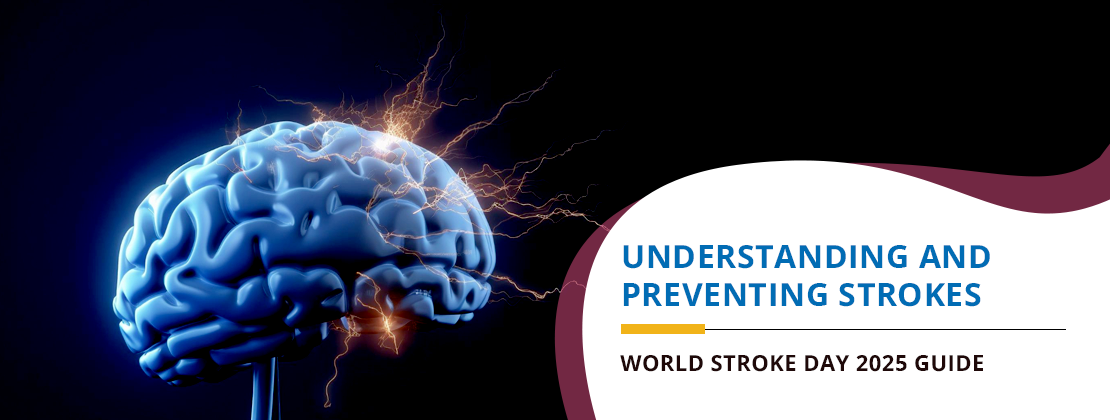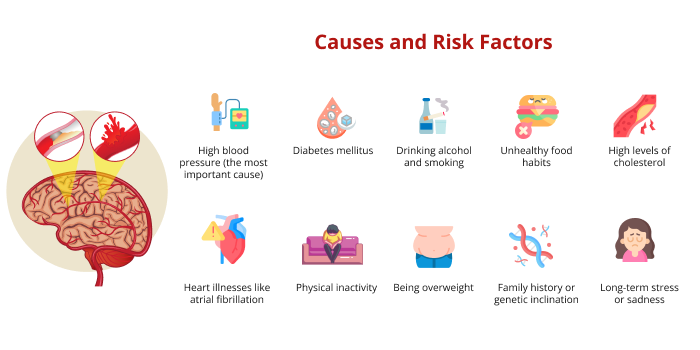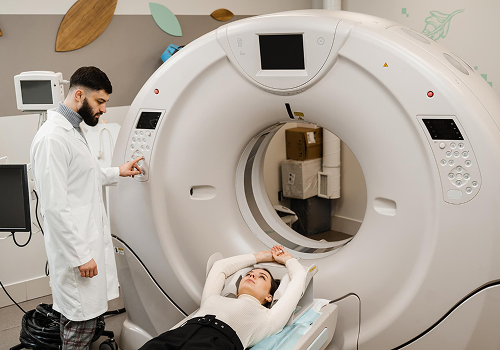
Home / Blog / Understanding and Preventing Strokes: World Stroke Day 2025 Guide
October 24, 2025
Stroke is one of the most common causes of mortality and long-term impairment in the world.
Millions of people are affected by this medical emergency every year, which may have been averted if they had assessed their risk early and made changes to their lifestyles.
As we observe World Stroke Day 2025, it’s important to talk about how important it is to reduce one’s stroke risk, recognise their risk factors and early signs, and receive timely treatment.
One of the key aspects of reducing your stroke risk includes prioritising your brain or neurological health. Opting for regular health checkups, seeing a specialist in case of alarming symptoms, and receiving necessary care are important.
HCG Hospitals, a top-ranking neuro hospital in Ahmedabad, offers comprehensive neurological services, which include everything from prevention and screening to treatment and follow-up.
To get in touch with the best stroke specialist in Ahmedabad, visit HCG Hospitals.
World Stroke Day is a day dedicated to raising awareness about stroke and its key aspects. It is observed every year on October 29th.
The World Stroke Organisation started observing World Stroke Day with the intent to raise awareness about stroke prevention, treatment, and recovery among the general population.
This day is a call to action for people and communities to learn how to spot the indications of a stroke early and get medical help right away.

“Every Minute Counts” is the theme for World Stroke Day 2025.
This theme stresses the importance of timely care for stroke victims. It also stresses making care more accessible by improving hospital infrastructure and providing support from many other fields.
The World Health Organisation (WHO) says that more than 12 million individuals around the world have a stroke every year, and around 6.5 million people succumb to it.
Stroke is still a major cause of disability, which has a big effect on quality of life and healthcare expenses. These reports also suggest that over 100 million people are living with the aftermath of a stroke.
Many of these strokes are caused by things that may be avoided, like high blood pressure, diabetes, smoking, and being overweight. It has been found that about 90% of stroke cases are linked to 10 modifiable risk factors.

A stroke happens when blood flow to a portion of the brain is cut off or slowed down. This cuts off oxygen and nutrients to brain tissue. Brain cells start to die within minutes. In general, strokes are divided into
Ischaemic stroke is a type of stroke that happens when a blood artery that supplies the brain gets blocked or clotted (85% of strokes).
A haemorrhagic stroke happens when a blood artery breaks, causing bleeding inside or around the brain.
The key risk factors for a stroke include:
It is important to learn about the different signs and symptoms of a stroke to make quick decisions when a stroke occurs. Some common signs are:
It’s very important to know the early signs of a stroke so that treatment can begin right away. The mnemonic FAST can help you identify critical symptoms of a stroke and seek timely interventions.
F – Drooping face: When you smile, one side of your face droops.
A – Weakness in the arms: When both arms are raised, one of them slides down.
S – Speech problems: Speech may be slurred or sound weird.
T – Time to call for aid: Getting medical treatment right away is very important.
Every second matters during a stroke. The sooner therapy starts, the more likely it is that you will get better.
Emergency medical care can get blood flowing again and stop more brain damage from happening. Hospitals with specialist stroke units make sure that patients get rapid care, such as clot-busting medicines or surgery when needed.
The stroke symptoms present rapidly, and hence, it is essential to seek immediate medical intervention.

An accurate diagnosis is essential for identifying the kind of stroke and formulating an appropriate treatment plan. Hospitals use the following advanced imaging and diagnostic tools to determine the severity of the stroke:
CT Scan: Finds bleeding or blockage in the brain.
MRI Brain Scan: Gives detailed pictures of the brain to check for damage to the tissue.
Ultrasound: Carotid ultrasound looks for plaque or narrowing in the arteries in the neck.
Echocardiogram: Finds the heart’s origins of clots.
Blood Tests: Blood tests check cholesterol, glucose, and coagulation levels.
In recent years, many multispeciality hospitals in India have been using AI-powered neuroimaging technologies to facilitate more accurate assessments and faster care delivery.
The nature and severity of the stroke determine the treatment:
This condition is treated with thrombolytic drugs (such as tPA) that break up blood clots. The best time to do this is within 3 to 4.5 hours of the first symptoms. In some circumstances, a minimally invasive treatment called mechanical thrombectomy may be done to get rid of big clots.
This stroke type is treated using surgical treatments like craniotomy to relieve pressure or fix broken blood arteries while keeping the blood pressure and swelling under control.
Supportive care includes oxygen and fluid supply and making sure vital signs are stable.
With comprehensive care at multispecialty hospitals, neurologists, neurosurgeons, and rehabilitation specialists can all work together to produce the greatest results.
Rehabilitation after a stroke is all about getting back lost abilities, becoming more independent, and stopping the problem from happening again.
After stroke treatment, depending on its severity, specialists may recommend the following supportive therapies:
Physical therapy: To help the patient get stronger and move around again
Occupational therapy: To aid the patient in regaining their abilities for day-to-day activities
Speech therapy: To address problems with talking and swallowing
Lifestyle Counselling: To guide the patient with their food habits, medications, and risk factors
Stroke survivors and their caregivers can deal with long-term changes better with the help of support groups, counselling, and family education.
If you suddenly experience weakness, feel confused, or have visual disturbances or a bad headache, you should see a doctor immediately.
Even if the symptoms go away in a few minutes, it could be a transient ischaemic attack (TIA), sometimes known as a mini-stroke, and you shouldn’t dismiss it.
A quick check-up at a neuro hospital or stroke care centre near you can help you prevent this medical emergency from occurring.
Within 10 minutes: Getting to emergency care and being examined
Within 25 minutes: Initial clinical examination and CT scan
Within 45 minutes: Confirming the diagnosis and deciding on treatment
Within an hour: Administering clot-busting medicine, if needed
Multidisciplinary care is the best way to get the best results after a stroke.
At HCG Hospitals, a leading neuro hospital in Ahmedabad, patients are looked after by a multidisciplinary team of specialists, including neurologists, neurosurgeons, physiotherapists, cardiologists, and psychologists.
The hospital also provides 24/7 emergency response, modern imaging, and specialist stroke ICUs, all of which are necessary for quick diagnosis and recovery.
The main point of World Stroke Day 2025 is clear: Act Fast, Save Lives. The first step in preventing a stroke is to be aware of your risk factors, spot the early indicators, and act right away.
You can lower your risk of having a stroke or surviving one by living a healthy lifestyle, getting regular check-ups, and seeking expert guidance at leading neuro hospitals.
Keep your blood pressure and blood sugar levels in check, don’t smoke, eat a balanced diet, remain active, and learn how to deal with stress.
A stroke happens when blood flow to a portion of the brain is cut off, which hurts the cells. It might be ischaemic (a clot) or haemorrhagic (a haemorrhage).
The main point of World Stroke Day is to raise awareness about the dangers of a stroke and the importance of its prevention, early detection, and timely management.
Family history of stroke is a very important risk factor, especially when combined with lifestyle risk factors like high cholesterol or high blood pressure. In such cases, individuals should meet a specialist to understand how to manage their stroke risk with appropriate preventive strategies.
Yes. High blood pressure, diabetes, atrial fibrillation, high cholesterol, and being overweight all raise the chance of having a stroke.
Long-term stress, anxiety, and depression can elevate blood pressure and inflammation, which can increase your chances of having a stroke.
Rehabilitation should start as soon as the patient’s condition is stable, ideally within 24 to 48 hours.
Yes. Leading hospitals in India are using AI-powered brain imaging, mobile stroke units, and tele-neurology consultations to change the way strokes are found and treated early.